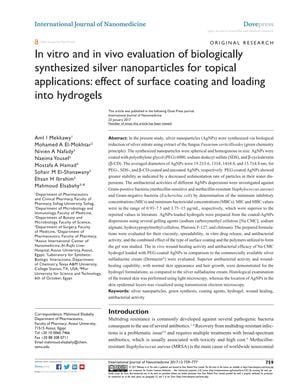In Vitro and In Vivo Evaluation of Biologically Synthesized Silver Nanoparticles for Topical Applications: Effect of Surface Coating and Loading into Hydrogels
January 2017
in “
International journal of nanomedicine
”

TLDR Silver nanoparticles coated with substances like PEG showed strong antibacterial effects and improved wound healing when used in hydrogels.
In a study from 2017, silver nanoparticles (AgNPs) were biologically synthesized using Fusarium verticillioides extract and coated with polyethylene glycol (PEG), sodium dodecyl sulfate (SDS), and β-cyclodextrin (β-CD), resulting in particles with average diameters ranging from 13 to 19.2 nm. PEG-coated AgNPs exhibited greater stability and all coated AgNPs showed superior antibacterial activity against both Gram-positive and Gram-negative bacteria, with MIC and MBC values between 0.93-7.5 µg/mL and 3.75-15 µg/mL, respectively. AgNPs were also loaded into hydrogels, which were tested for viscosity, spreadability, drug release, and antibacterial activity. The in vivo study demonstrated that a hydrogel loaded with PEG-coated AgNPs had better antibacterial and wound-healing performance compared to a commercial silver sulfadiazine cream, with the added benefit of normal skin appearance and hair growth. Histological and transmission electron microscopy confirmed the effective skin penetration and localization of AgNPs.

